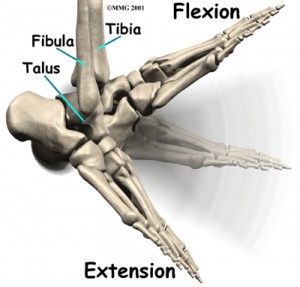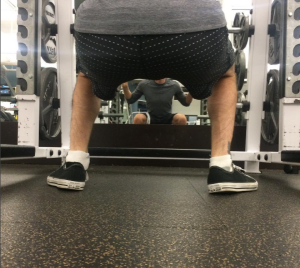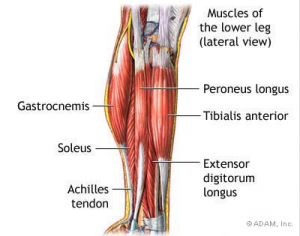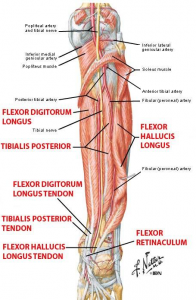Foot and Ankle Stuff for Meatheads
I’m sure you want to start your 2016 off by getting your learn on about feet and ankles and all the stuff that doesn’t sound as sexy as biceps or Instagram abs or any of that stuff. Bear with me and I’ll show you why this kind of work can be so impactful and awesome at the same time so that you can set up to deadlift, squat, run, jump and do all the other awesome stuff you want to do with way more effectiveness, and lead to teh sexay. Sounds good, don’t it?
I used to work in a tire bay for a heavy truck repair center. This place worked on Peterbuilts, Mac trucks, and a bunch of other 18 wheelers, and tires were kind of a big deal. At least that’s what I told myself to feel good about myself while the mechanics were actually fixing stuff. The tires had to bear the load of the trucks and cargo, plus generate enough friction with the road to keep from sliding off, and have enough of a lifespan to not wear out every single day.
If you ever go to a drag strip and watch some of the cars race there, you’ll see they all use somewhat different tires for what they have to do compared to a big rig. They have softer compounds, generally are inflated to higher pressures, and aren’t as concerned about lifespan as much as getting friction with the road without slowing them down.
The important thing to consider is the tires make a big difference in getting the job done that they’re required to do, whether that’s haul a heavy load for 10,000 miles or shave 1/100th of a second off quarter mile time.
Your feet and ankles are your tires. They’re the first thing to come in contact with the ground, and have to do the jobs required of them or they’ll likely not help your performance. They have to be strong enough to handle heavy loading, flexible enough to go up and down stairs and squat, moldable to conform to the surface you’re standing on to help you keep your balance, and responsive enough to do all of this quickly when required.
In a gym setting, many people seem to forget about foot strength and the role it plays in activities like squats and deadlifts, plus any non-machine based movements you might want to do. In martial arts, foot strength is a major focus, not just for kicking someone’s face through the back of their head, but also for balance and shifting weight to not get taken down. In dance it’s the same thing, except way fewer head shots and tap outs.
Ankle dorsiflexion tends to not get the credit it deserves in terms of how impactful it is to overall movement. In looking at dorsiflexion, it’s best to describe it as forward movement of the tibia over the talus.
If the person doesn’t have sufficient range of motion through this joint during flexion movements, they tend to find it through a drop of the naviculus, which leads to their feet pronating and rolling inward.
When you see this during a squat movement, the feet will tend to turn out to accomodate the lack of dorsiflexion, and then the feet drop in as shown above. This becomes very apparent when you look at the feet and ankles from behind during the squat. There could also be some rear foot eversion of the calcaneous too.
That’s the cool thing about the body: if you don’t have range of motion in one joint, it will still find a way to get the job done by finding the range at another joint. We can see this time and time again in all movements. Low back rounding during a deadlift from insufficient hip flexion, thoracic extension when overhead reaching or pressing due to shoulder stiffness, and nerds living out their fantasies through comic books due to an inability to talk to girls.
This may not seem like much, but looking at the research:
- Amaree et al showed decreased ankle dorsiflexion was correlated to ACL injury risk, whereas Q angle wasn’t correlated
- Cheuy et al showed diabetic neuropathic deterioration of forefoot strength negatively impacted dorsiflexion, and lead to faster deterioration of the metatarsophelangeal joint in those who had the greatest reduction in dorsiflexion
- Sadeghi-Demneh et al showed obese adolescences had a greater occurence of flat feet, reduced ankle dorsiflexion, and higher occurence of knww and ankle pain during physical activity, which limited their participation.
- Evangelopolous et al showed externally restricting ankle range of motion with a brace caused alterations to leg swing mechanics of the hip to clear an obstacle compared to unrestricted clearance.
- Koyama et al showed patients with knee osteoarthritis could descend stairs with a greater margin of stability and take less time to accomplish the task if they had greater ankle dorsiflexion, regardless of the stage of deterioration of the knee.
- Kim et al showed that ankle dorsiflexion was a greater predictor of overall squat depth than hip flexion, and that strengthening ankle dorsiflexion would provide greater improvements in squat depth than not involving dorsiflexion strengthening.
- Dill et al showed greater ankle dorsiflexion had greater knee varus motion. Valgus motion is when the knees come together, and has been shown as a predictor of ACL injury during squats and jump landings.
- Power & Clifford showed that rearfoot kinematics were altered in squatting when comparing barefoot and 10mm orthosis squats in participants who excessively pronate. The range of motion was signficiantly improved in ankle dorsiflexion and hip motion with those who used the orthosis.
- Macrum et al showed using a small heel wedge reduced quad activity, increased soleus activity, increased knee flexion, and didn’t alter hip motion compared to flat foot squatting, and this pattern is consistent with one seen in patients with patellofemoral pain syndrome.
To summarize: dorsiflexion is important for health, performance, injury prevention, and being able to workout like a goddamn ninja. – CLICK TO TWEET THIS
Now the range of motion you can accomplish through dorsiflexion can be limited by a couple of things. First, if your joint capsule has some significant stiffness to it, previous injuries (ankle rolls, etc) or has been immobilized for a while like in an ankle cast, your mobility will likely be limited regardless of what else may be going on. There’s some small joint mobilization techniques you can do on your own, but it would be worthwhile to get a professional who knows how to mobilize that stuff to get in there and give it a whirl. Also a consideration, if you stretch into dorsiflexion and you feel a pinching sensation on either the front of the ankle or the back of the ankle, it might need some specific attention before you start jamming on it.
If the front of the ankle pinches, this is what’s known as a closing joint pinch from FRC circles. Dr. Andreo Spina does a great job of talking about this with the hip assessment in this video.
Aside from capsular stuff, there could also be a muscle tension thing getting in the way. If you have chronically tight calves and they hurt when you stretch, this could be a sign you need some dedicated soft tissue work, or need to get aggressive with some foam rolling work. It could also mean you’re using your calves to do stuff like walk with a very hard toe off, or you aren’t initiating contact with the heel when your foot hits the ground. Aside from that, some basic ankle dorsiflexion stretches will help, which we’ll get to in a minute.
When looking at dorsiflexion and alignment, it’s necessary to consider whether there is enough lateral support of the ankle to get it into a position where actual dorsiflexion occurs versus the pronated version discussed earlier is the dominant aspect. There’s muscles on the inner and outer edges of the shin that control the lateral movement of the ankle and heel, and if they’re weak or not doing what they’re supposed to, you can get into that pronated position relatively easily.
The main muscles to consider are the tibialis anterior, tibialis posterior, flexor hallicus group, and peroneal groups. Here’s a few pics to show where they are.
Essentially, these two groups of muscles act like stirrups on either side of the ankle, providing some stability to lateral force application, steering the foot as needed, and helping out with flexion and extension as needed. In many cases where a person has flat feet, these muscles aren’t working all that well to develop force, do it quickly in response to a changing stimulus (unstable surface or sudden impact), or just aren’t even considered an entity at all during activities. The fact that the glute medius was blamed for years for being the culprit for valgus collapse and no attention was paid to the muscles that actually steer foot and ankle movement which directly effects knee positioning shows how little love these buggers get.
Strengthening these muscles isn’t difficult, but definitely less sexy than glute training in shorty shorts, which is why you probably don’t see a lot of it on Instagram.
Let’s start by looking at doing some soft tissue addressing with the foot and shin, and then go into how to actually use your foot to create an arch.
This arch creation involves using the muscles of the foot to pull you from more of a pronated position to more of a supinated position. Think of putting more weight on the baby toe side of the foot versus on the big toe side, then pull the ball of your foot towards your heel without digging your toes into the ground.
Once you’re able to do some of the foot positioning work to get the arch to form, you should feel like your feet, calves, and ankles are working to get there. That’s good. From that we can add some resistance to also give some feedback on your positioning, and also work on building some endurance with isometric holds in the position.
From here you can work on getting some dorsiflexion while also holding that lateral tension position by wrapping the band around your ankle and fixing it to a solid point to pull your ankle in to more pronation, meaning you have to push out into supination, then doing a dorsiflexion lean like this.
To further increase the complexity of this challenge, we can involve the supinated band resistance with an active dorsiflexion through a squat. The key thing to think about is that the ankle has to press out into the band the entire time without letting you go into pronation and having the band go slack. If you’re going deep and wind up dropping into pronation, it’s defeating the purpose of the drill, so limit yourself to the point where you lose position of the ankle, if at all.
If you want to feel really bad about how little dorsiflexion you can use, try this next one out. Go into a half kneeling position, and lean on the front knee while going into dorsiflexion. When you get to the end of the range of motion, try to brace your abs, then lift the foot off the floor through active contraction of the tibialis anterior, then roll back without letting the foot fall out of that max dorsiflexion.
This is a take-off on an FRC lift-off concept, and one that proves to not only be challenging, but very beneficial to produce range of motion plus strengthening the dorsiflexors, which based on some of the research shown earlier is massively impactful to squat performance. A key on this is how hard you work to keep the foot in dorsiflexion. It’s not a simple easy contraction, but a life or death effort where you should be sweating buckets by the time you’re done rep one.
From there we can start looking at the foot itself. The metatarsal joints through the ball of the foot tend to not get the love they deserve, even though they direct traffic through what’s happening in the foot. A simple rolling drill where you go from a squat position to putting your knees down on the ground while the balls of your feet stay put can seem very simple, but if you’re restricted through the metatarsal joints, can prove quite eye-opening.
Now let’s get everything involved in the process.
Doing a 1-foot squat with a band pulling your knee into valgus makes the foot work a lot harder to resist pronation, plus starts getting the legs involved even more with some compound movement and added resistance.
Now let’s work outside of the saggital plane and get some rotational control of the foot and ankle.
And if you want to get even more footy action going on, check out Luke Summers going barefoot on battle ropes to train the foot muscles to deform to the surface of the ropes, create stability and balance, and doing so through a variety of stances and positions.
There’s a lot of value to training foot and ankle strength and range of motion, even to bros looking to get their swole on, and especially if those bros have some foot, knee, or hip issues that could be keeping them from training as hard as they want to see the gains they’re looking for. It’s admittedly not sexy, but then again not being able to go down a flight of stairs without a hand rail isn’t sexy either, so I guess you can pick what kind of sexy you want to use now and use then.
However, I would say that changing your mindset about these kinds of drills to one where you see how much potential there is versus just doing mindless rehab-like exercises, and how much this can affect your workouts and give you more options to do way more cool stuff than just targeting your teardrop quad muscle can help excite you to train in some different ways than you probably would have before. Maybe you’ll take this to heart and start working on some advanced balancing or range of motion development and become some sort of internet movement guru or something.
Or just squat like you’re not a broken hinge and not hate life while walking around for a day. Whatevs.






4 Responses to Foot and Ankle Stuff for Meatheads